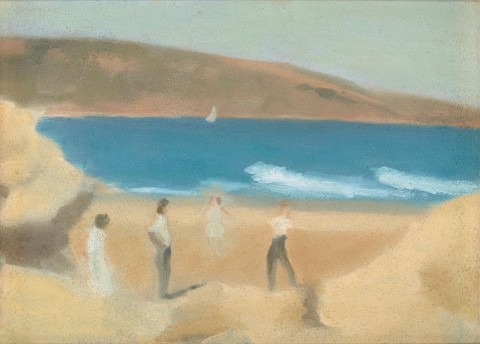ANGLESEA, 1929
CLARICE BECKETT
oil on pulpboard
24.5 x 34.5 cm
Rosalind Humphries Galleries, Melbourne (label attached verso)
Private collection, Melbourne, acquired from the above in 1971
Thence by descent
Private collection, Melbourne
probably: Clarice Beckett, Athenaeum Gallery, Melbourne, 17 – 25 October 1930
Wet sand, Anglesea (Sunrise, Anglesea), 1929, oil on board, 28.0 x 38.0 cm, Private collection, Melbourne
White Road, Anglesea, oil on board, 32.5 x 39.0 cm, Deutscher and Hackett, Sydney, 1 September 2010, lot 120
Clarice Beckett’s paintings are a record of her life, her wanderings, her friends and above all, of her singular painterly vision. In 1917, following two years of study at Melbourne’s National Gallery School under Frederick McCubbin, she attended a public lecture by Max Meldrum at the Athenaeum Theatre, where he expounded his personally devised theory of ‘optical science’ for painting, known now as ‘tonalism’. Impressed by what she heard, Beckett enrolled in his class. After a year, she went out on her own but Meldrum had been equally impressed, naming her as his best student ever more. Restricted in her social activities by a domestic life spent looking after her increasingly frail parents, Beckett’s interactions with her fellow ‘Meldrumites’ were rare. However, she was able to attend occasional painting retreats with them, and Anglesea, 1929, is a charming record of their first such trip, to this Victorian coastal town at the start of the Great Ocean Road.
‘Tonalism’ was a controversial movement that rejected most contemporary modernist theories to concentrate solely on tone and form to create an image, rather than through the utilisation of pure colour or academic drawing. It attracted criticism not only from the prevailing conservative, male critics of the day, but also the country’s fledgling modernists. As a woman, Beckett was doubly criticised. Her story has become something of a legend within Australian art history and whilst it is true that her last years were sad, this aspect obscures the positive elements of her life: her tenacity, her self-belief, her multiple solo exhibitions (twelve between 1923 and 1933!), and her participation in numerous group shows as well. What is tragic is that so many of her paintings were ruined through poor storage following her death. Those that did survive, such as Anglesea, are therefore much treasured.
An uncharacteristically sun-drenched work, this scene depicts Beckett’s companions on the foreshore in front of what is now the Anglesea Caravan Park. A land of rich resources for the Wathaurong people, the area had been popular with campers from Geelong since the 1860s. Like all of Beckett’s outdoor images, it was painted in one plein air session, capturing her friends on a perfect summer’s day without a cloud in the sky, and only a single distant yacht sharing the experience. Beckett has utilised broad, simplified bands of colour – caramel and blue highlighted by white – with the only pronounced brush stokes representing the waves rolling to the shore and the casual poses of the figures. Anglesea, is also an environmental record of the time for the foreshore has been much changed by ninety years of storms and erosion. The beach remains but the ochre-coloured limestone cliffs have crumbled leaving the shore strewn with large boulders. Beckett included a group of Anglesea paintings in her solo exhibition at the Athenaeum Gallery in October 1930. The reviewer for the Bulletin was one who recognised their quality stating emphatically that she was now, in his opinion, ‘the most original painter in Australia.’1
1. 'The Palette', Bulletin, 29 October 1930, p. 33
ANDREW GAYNOR
